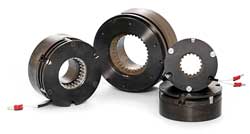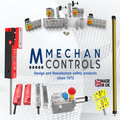
Posted to News on 25th Nov 2009, 12:26
Brakes enhance safety of servo-drive machines
Peter Anderson of Matrix International, an Altra Group company, explains how electromechanical brakes for servomotors help to make machines safer, more reliable and more controllable.

Fast, powerful and highly controllable, servomotors are an essential part of many modern machine designs. But what happens when the power shuts down? Without energy to control the position of the motor shaft, it will tend to move in response to whatever external loads are applied at the time. At best, this means that an emergency shutdown or an unexpected loss of power can result in a machine going out of sync. At worst, uncontrolled motion can present a significant safety risk.
Fortunately, machine designers have a simple, compact and cost-effective solution to this problem available to them. Spring-applied electromagnetic brakes can safely bring a motor to a stop, or hold its static position, without the need for external power. Matrix, part of the Altra power transmission group, has been designing and supplying such brakes for more than 30 years. Servo motor brakes are robust and reliable. Their integration requires care, however, and full consideration must be given to the specific characteristics of each motor installation.
A servomotor is a highly dynamic, high-speed electric motor, used normally with a speed reduction gearbox, in industrial applications such as automation and material handling systems. The emphasis is often on a rapid duty cycle with fast rates of acceleration and deceleration. To achieve this, servomotors are made to minimum dimensions; usually a compact square section is preferable to a short overall length to keep the motor inertia low. For some applications, a short 'pancake' servomotor is used.
The most common and cost-effective brake for the majority of servo motor applications is the spring-applied design. These brakes operate by applying the force of a spring to a friction plate mounted on the motor shaft. In operation, a DC voltage applied to a coil disengages the brake. If the voltage is removed, the brake activates. The Matrix 1EB range is an example of this brake type. Over the past three decades, the company has produced more than 700 different variants of the design.
Design considerations
When selecting an appropriate brake for a servo motor application, the designer must think carefully about the operating conditions and demands of the application; the selected brake must have sufficient static (holding) torque to keep the shaft in position under all operating conditions. The orientation of the motor should be established, especially if its axis is not horizontal, as this can affect loads experienced by the brake.
In a highly dynamic application, the brake hub and friction plate should have minimum inertia, as this inertia adds to that which must be accelerated and decelerated by the motor, thereby increasing its power requirement. The brake dimensions must be kept to a minimum for a given static torque; servomotors usually have a small diameter and the brake diameter must be smaller, while keeping the brake's overall length to a minimum.
Assembly considerations are important too. How the static parts of the brake are fitted to the motor, to maintain the brake's concentricity and squareness to the motor shaft, must be considered at the design stage. How is the brake hub to be fastened to the motor shaft, with regard to torque transmission and axial location? Normally a bore and keyway would be used, but other methods could include shrink fit, driving pin or a D connection. If space is restricted, can a spline be machined on the motor shaft?
Electrical considerations
As well as mechanical design requirements, electrical aspects of the installation need careful thought. The power absorbed by the brake coil should be kept to a minimum, as the brake coil is continuously powered while the motor is in use, generating heat in a confined space with high ambient temperatures (up to 150degC). How the brake coil is to be wired into the motor, and the length and termination of any flying leads must be specified. It is necessary to find out if any regulations apply to this wiring and any connectors used.
The brake coil requires a DC voltage, which is normally provided by rectifying the AC voltage used to power the motor. The motor designer must take care to ensure that the DC voltage and current to keep the brake disengaged are always supplied to the brake coil while the motor is running. This is important, as a servomotor's speed can be controlled by varying the supply voltage. The speed of electrical response in the brake control circuit must also be considered so as to ensure that the brake is disengaged before the motor begins to rotate. The motor designer will need to consider this timing in the event that the motor is controlling falling loads, such as lifts or cranes.
Low noise can be a consideration, for example in medical or theatre applications. This noise can be from the 'clunk' of engagement or disengagement, or the rattle of the brake hub/friction plate spline if torsional vibration or driveline ripple is present in the drive train. Matrix has ways of minimising these noises.
What the customer expects to happen in an emergency stop (ie loss of power when the motor is in a dynamic condition) should also be considered, as these brakes have a limited ability to absorb energy. If the brake can handle the energy of a single dynamic stop, the frequency of these dynamic stops should be determined, as the wear life of the friction material is a consideration.
Backlash
In many safety-critical applications it is sufficient that the brake can bring the motor to a controlled stop or hold it in approximate position in the event of power loss. In some high-precision applications, however, where many different servomotors may operate in exact synchronisation, there is a need to control the precise position of the motor shaft. Here the designer must consider the degree of backlash inherent in the brake design.
Spring-applied brakes have a small but significant backlash. In many cases, such as where the motor is coupled to a gearbox which itself exhibits backlash, backlash in the brake will be lower than that exhibited by other parts of the system and the spring-applied design will provide adequate precision. In some cases, however, the need for a zero-backlash brake calls for a different design altogether. Permanent magnet brakes (such as the Matrix 4PMB range) offer this capability. In this design permanent magnets generate the braking force. A DC voltage applied to the coil generates a magnetic force that opposes that from the permanent magnet, and a release spring disengages the brake.
Demanding designs
Matrix supplies many of the leading servomotor manufacturers in Europe and America. Over a 30-year period, Matrix has developed solutions to all the problems that have been experienced in specific applications. An experienced design and development team are continuously developing the 1EB product range and evaluating new and alternative materials. Design engineers use a finite element analysis (FEA) package to optimise the magnetic path within the brakes to maximise torque and minimise power consumption while keeping costs to a minimum.
Matrix quality systems are accredited to ISO 9001, ensuring that product design and development, manufacturing and service are of the highest standard. The servomotor market is very cost-conscious, so Matrix has refined its manufacturing and supply chain to maximise cost-effectiveness, while supplying a product that will meet customers' application needs. Being part of Altra has helped this evolution considerably, making the company a much larger player in the world power transmission market, with access to suppliers and manufacturing resources worldwide.
Follow the link for more information about Matrix servo motor brakes.
Want the latest machine building news straight to your inbox? Become a MachineBuilding member for free today >>















